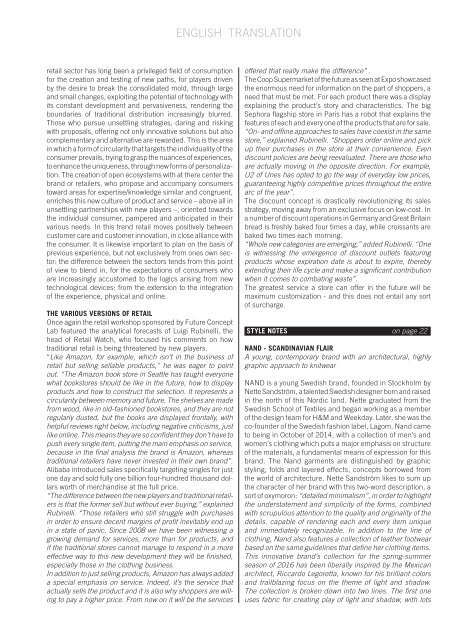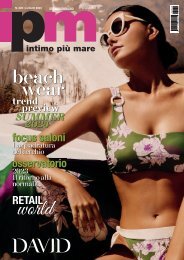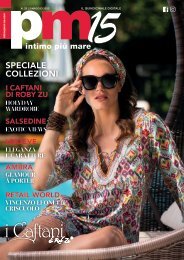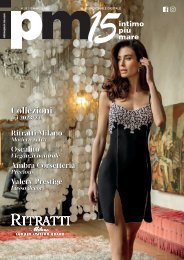You also want an ePaper? Increase the reach of your titles
YUMPU automatically turns print PDFs into web optimized ePapers that Google loves.
ENGLISH TRANSLATION<br />
retail sector has long been a privileged field of consumption<br />
for the creation and testing of new paths, for players driven<br />
by the desire to break the consolidated mold, through large<br />
and small changes, exploiting the potential of technology with<br />
its constant development and pervasiveness, rendering the<br />
boundaries of traditional distribution increasingly blurred.<br />
Those who pursue unsettling strategies, daring and risking<br />
with proposals, offering not only innovative solutions but also<br />
complementary and alternative are rewarded. This is the area<br />
in which a form of circularity that targets the individuality of the<br />
consumer prevails, trying to grasp the nuances of experiences,<br />
to enhance the uniqueness, through new forms of personalization.<br />
The creation of open ecosystems with at there center the<br />
brand or retailers, who propose and accompany consumers<br />
toward areas for expertise/knowledge similar and congruent,<br />
enriches this new culture of product and service – above all in<br />
unsettling partnerships with new players –, oriented towards<br />
the individual consumer, pampered and anticipated in their<br />
various needs. In this trend retail moves positively between<br />
customer care and customer innovation, in close alliance with<br />
the consumer. It is likewise important to plan on the basis of<br />
previous experience, but not exclusively from ones own sector:<br />
the difference between the sectors tends from this point<br />
of view to blend in, for the expectations of consumers who<br />
are increasingly accustomed to the logics arising from new<br />
technological devices: from the extension to the integration<br />
of the experience, physical and online.<br />
THE VARIOUS VERSIONS OF RETAIL<br />
Once again the retail workshop sponsored by Future Concept<br />
Lab featured the analytical forecasts of Luigi Rubinelli, the<br />
head of Retail Watch, who focused his comments on how<br />
traditional retail is being threatened by new players.<br />
“Like Amazon, for example, which isn’t in the business of<br />
retail but selling sellable products,” he was eager to point<br />
out. “The Amazon book store in Seattle has taught everyone<br />
what bookstores should be like in the future, how to display<br />
products and how to construct the selection. It represents a<br />
circularity between memory and future. The shelves are made<br />
from wood, like in old-fashioned bookstores, and they are not<br />
regularly dusted, but the books are displayed frontally, with<br />
helpful reviews right below, including negative criticisms, just<br />
like online. This means they are so confident they don’t have to<br />
push every single item, putting the main emphasis on service,<br />
because in the final analysis the brand is Amazon, whereas<br />
traditional retailers have never invested in their own brand”.<br />
Alibaba introduced sales specifically targeting singles for just<br />
one day and sold fully one billion four-hundred thousand dollars<br />
worth of merchandise at the full price.<br />
“The difference between the new players and traditional retailers<br />
is that the former sell but without ever buying,” explained<br />
Rubinelli. “Those retailers who still struggle with purchases<br />
in order to ensure decent margins of profit inevitably end up<br />
in a state of panic. Since 2008 we have been witnessing a<br />
growing demand for services, more than for products, and<br />
if the traditional stores cannot manage to respond in a more<br />
effective way to this new development they will be finished,<br />
especially those in the clothing business.<br />
In addition to just selling products, Amazon has always added<br />
a special emphasis on service. Indeed, it’s the service that<br />
actually sells the product and it is also why shoppers are willing<br />
to pay a higher price. From now on it will be the services<br />
offered that really make the difference” .<br />
The Coop Supermarket of the future as seen at Expo showcased<br />
the enormous need for information on the part of shoppers, a<br />
need that must be met. For each product there was a display<br />
explaining the product’s story and characteristics. The big<br />
Sephora flagship store in Paris has a robot that explains the<br />
features of each and every one of the products that are for sale.<br />
“On- and offline approaches to sales have coexist in the same<br />
store,” explained Rubinelli. “Shoppers order online and pick<br />
up their purchases in the store at their convenience. Even<br />
discount policies are being reevaluated. There are those who<br />
are actually moving in the opposite direction. For example,<br />
U2 of Unes has opted to go the way of everyday low prices,<br />
guaranteeing highly competitive prices throughout the entire<br />
arc of the year”.<br />
The discount concept is drastically revolutionizing its sales<br />
strategy, moving away from an exclusive focus on low-cost. In<br />
a number of discount operations in Germany and Great Britain<br />
bread is freshly baked four times a day, while croissants are<br />
baked two times each morning.<br />
“Whole new categories are emerging,” added Rubinelli. “One<br />
is witnessing the emergence of discount outlets featuring<br />
products whose expiration date is about to expire, thereby<br />
extending their life cycle and make a significant contribution<br />
when it comes to combating waste”.<br />
The greatest service a store can offer in the future will be<br />
maximum customization - and this does not entail any sort<br />
of surcharge.<br />
STYLE NOTES on page 22<br />
NAND - SCANDINAVIAN FLAIR<br />
A young, contemporary brand with an architectural, highly<br />
graphic approach to knitwear<br />
NAND is a young Swedish brand, founded in Stockholm by<br />
Nette Sandström, a talented Swedish designer born and raised<br />
in the north of this Nordic land. Nette graduated from the<br />
Swedish School of Textiles and began working as a member<br />
of the design team for H&M and Weekday. Later, she was the<br />
co-founder of the Swedish fashion label, Lagom. Nand came<br />
to being in October of 2014, with a collection of men’s and<br />
women’s clothing which puts a major emphasis on structure<br />
of the materials, a fundamental means of expression for this<br />
brand. The Nand garments are distinguished by graphic<br />
styling, folds and layered effects, concepts borrowed from<br />
the world of architecture. Nette Sandström likes to sum up<br />
the character of her brand with this two-word description, a<br />
sort of oxymoron: “detailed minimalism”, in order to highlight<br />
the understatement and simplicity of the forms, combined<br />
with scrupulous attention to the quality and originality of the<br />
details, capable of rendering each and every item unique<br />
and immediately recognizable. In addition to the line of<br />
clothing, Nand also features a collection of leather footwear<br />
based on the same guidelines that define her clothing items.<br />
This innovative brand’s collection for the spring-summer<br />
season of <strong>2016</strong> has been liberally inspired by the Mexican<br />
architect, Riccardo Legoretta, known for his brilliant colors<br />
and trailblazing focus on the theme of light and shadow.<br />
The collection is broken down into two lines. The first one<br />
uses fabric for creating play of light and shadow, with lots


















